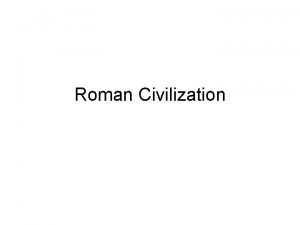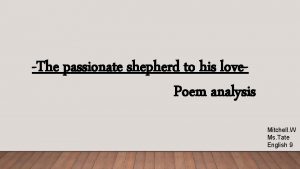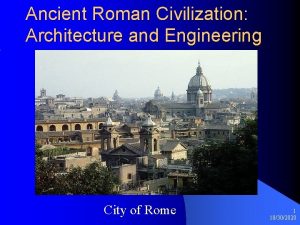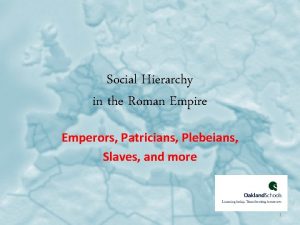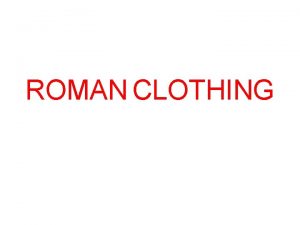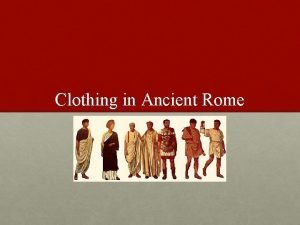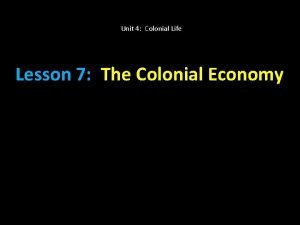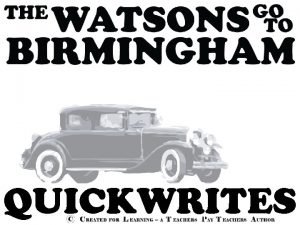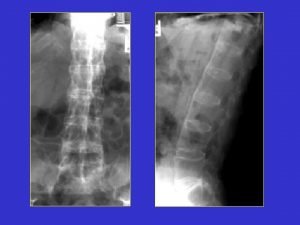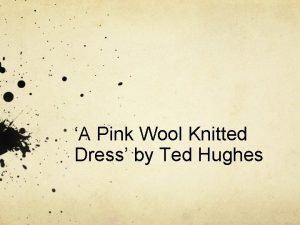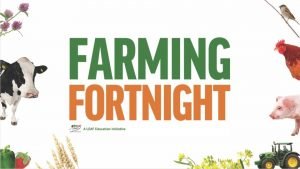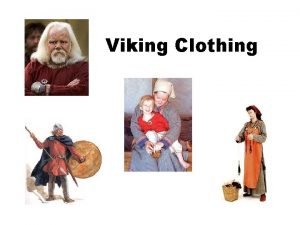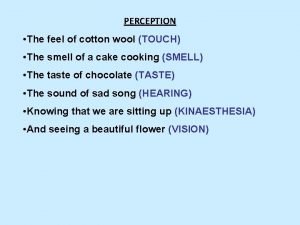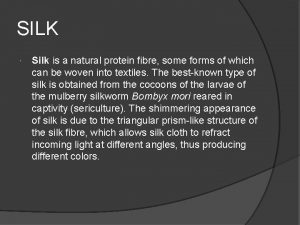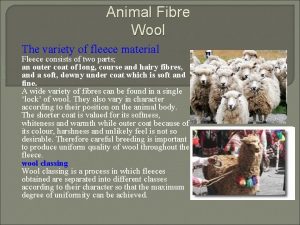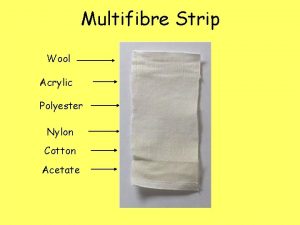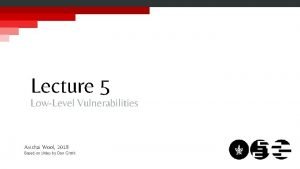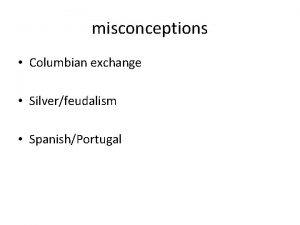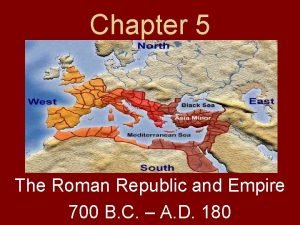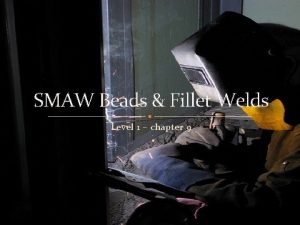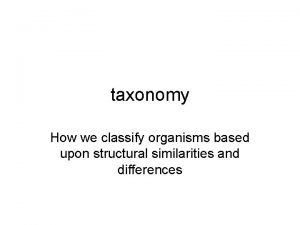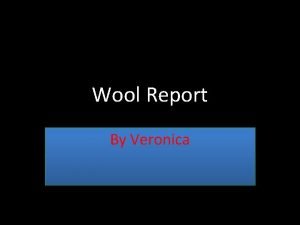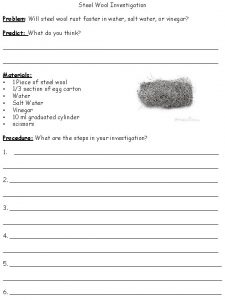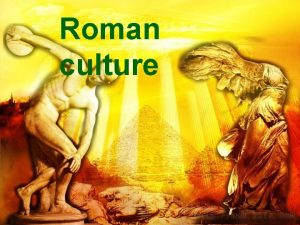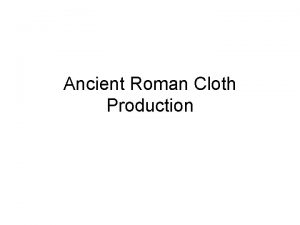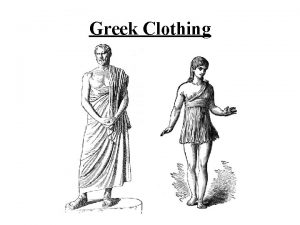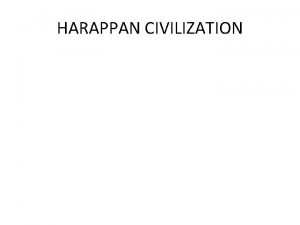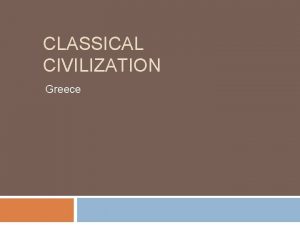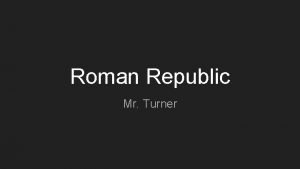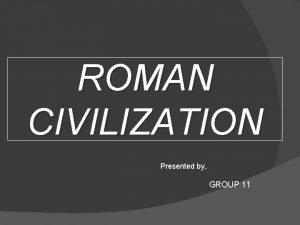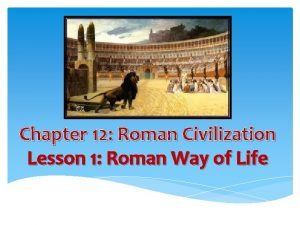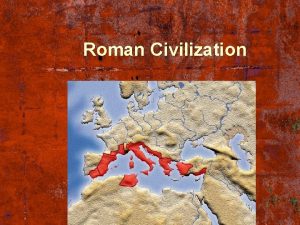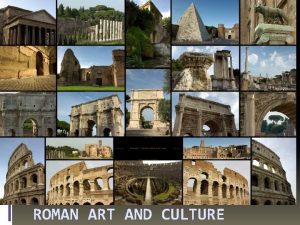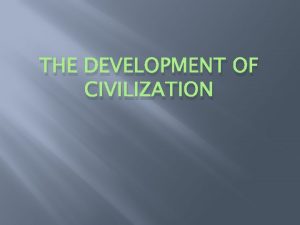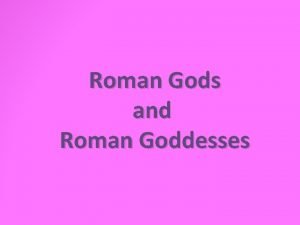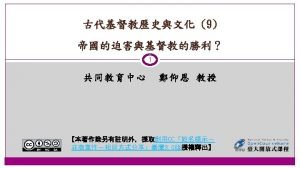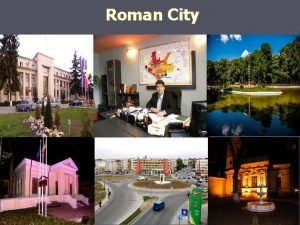Roman Civilization Clothing Most clothing made of wool





































- Slides: 37

Roman Civilization

Clothing • Most clothing made of wool, some linen and silk • 2 types: indutus = put on amictus = wrapped • Subligaculum = loincloth/underwear • Tunica = tunic (long shirt) – Tunica manicata = long sleeve tunic – Tunica talares = floor length tunic

Clothing (cont. ) • Tunica angusti clavi = tunic worn by equites with narrow purple stripes • Tunica lati clavi = tunic worn by senators with wide purple stripes • Wrappings for warmth (worn only by old or ill people) legs=fasciae upper leg=feminalia lower leg=tibialia body=ventralia throat=focalia • Pants (worn only by barbarians) = braccae

Clothing (cont. ) • Toga was the mark of a Roman citizen • Regular toga = toga pura/virilis/libera • Toga candida/splendens = worn by men running for public office, candidati, bright white color • Toga praetexta = worn by boys before manhood and curule magistrates, purple border

Clothing (cont. ) • Toga picta = worn by triumphing generals and emperors, entirely purple • Toga sordidata/pulla = worn by people in mourning, dingy toga • Lacerna = more convenient mantle that eventually nearly replaced the toga, came in many colors, could have a hood (cucullus) • Military cloak = trabea, paludamentum, sagum, similar to lacerna but heavier

Clothing (cont. ) • Paenula = wrap used for protection from weather and cold, similar to a poncho, no sleeves • Synthesis = dinner garment • Laena, abolla = very heavy cloaks • Endormis = bath robe

Clothing (cont. ) • • • Sandals = soleae Shoes = calcei Mulleus = patrician’s shoe Calceus senatorius = senator’s shoe Perones = shoes of untanned leather Caligae = soldiers’ half boot

Clothing (cont. ) • Pilleus = felt cap, worn by lower classes, especially workmen • Causia/petasus = broad-brimmed felt hat worn for protection from the sun • Beards worn after the reign of Hadrian • Only jewelry worn by a roman citizen was a ring, often a seal ring, worn on the joint

Clothing (cont. ) • 3 main articles make up women’s clothing, tunica, stola, and palla • Tunica is similar to that of a man • Mamillare = band of soft leather worn similar to modern bra • Strophium = sash worn over tunica • Stola is the distinctive dress of a matron • Stola had a wide border (instita) at the lower hem and a girdle (zona)

Clothing (cont. ) • Palla = shawl-like wrap for outdoors • Women worn the same soleae and calcei as men • Nodus = hair gathered in a knot on the back of the neck • Reticula = hair nets • Vittae/taeniae/fasciolae = hair ribbons • Coronae = garlands of flowers

Clothing (cont. ) • • Umbraculum/umbella = parasol Flabellum = fan Sudaria = handkerchiefs Roman women wore many types of jewelry, rings, brooches, pins, coronets, bracelets, necklaces, earrings, and pendants • Pearl was the favorite jewel

Living Arrangement • • Domus = house Atrium = main room Compluvium = pool to collect rain water Impluvium = hole in the roof of the atrium to let in light, air, and rainwater, 4 types – Tuscanicum = 2 pairs of beams at right angles – Tetrastylon = similar to Tuscanicum, but with pillars at the intersections – Corinthium = More pillars than tetrastylon – Displuviatum = roof sloping outward to carry water away, only rain falling directly went into the compluvium – Atrium testudinatum had no impluvium

Living Arrangement (cont. ) • Tablinum = Study/office • Arca = strong box for valuables, in atrium or tablinum • Alae = wider parts of the atrium • Peristylium = colonnaded courtyard behind the tablinum • Vestibulum = open court between the street and building

Living Arrangement (cont. ) • Ostium = entrance to the house, door and doorway, ianua/fores = specifically door • Limen = threshold • Culina = kitchen • Latrina = bathhouse • Triclinium = dining room, 3 couches • Cubiculum = bedroom • Bibliotheca = library

Living Arrangement (cont. ) • Sacrarium = private chapel • Oecus = sitting room/parlor, used also as a banquet hall • Exedra = room with permanent seats, probably for lectures or similar purpose • Solarium = place to sit in the sun, often on the flat roof, decorated with flowers and shrubs • Cella servorum = slaves’ quarters

Living Arrangement (cont. ) • Paries = wall, made of various materials, often fronted with marble stucco • Lateres crudi = stone or unburned brick • Opus quadratum = dressed stone • Opus caementicum = concrete • Lapis Puteolanus = concrete made of lime and volcanic ashes with pieces of stone • Lateres cocti = kiln-burned brick

Living Arrangement (cont. ) • Wall frontings, either opus incertum (flat faces of rocks with no particular shape or pattern) or opus reticulatum (flat faces of stone cut into uniform squares, giving a pattern like a net) • Solum = floor • Pavimentum = floor covered by stone, brick, tile, and potsherds, smoothed with a heavy rammer (fistuca)

Living Arrangement (cont. ) • Poorer homes had pavimentum floors, richer had stone slabs fitted together, some had concrete floors • Floors of upper stories were either made of wood or concrete • Tectum = roof, usually made of tiles • Tegula =tile, made with flanges to fit together • Imbrices = Tiles made to cover the flanges

Living Arrangement (cont. ) • 4 parts to doorway, threshold (limen) two jambs (postes) and lintel (limen superum) • Door hinge was a cylinder turning in sockets in the threshold and lintel, similar to a modern gate • Fores = double doors • Posticum = back door • Pessuli = bolts Serae = bars

Living Arrangement (cont. ) • • Fenestra = window Foculi = metal coal boxes used for heating Some wealthy homes had furnaces Water could be piped into the house from mains laid down in the middle of streets • Often a tank for water in the upper part of the house and a fountain in the court

Living Arrangement (cont. ) • • • Lectus = couch/bed Sedile = backless stool, most primitive seat Sella = stool, ordinary seat for one Subsellium = bench, used in the Senate Sella curulis = stool with curved, folding ivory legs, used by magistrates • Solium = high backed chair with solid arms • Cathedra = curved back chair with no arms

Living Arrangement (cont. ) • Mensa = table • Monopodium = table with one support, used often for a lamp • Abacus = rectangular top with raised rim, used just as a modern sideboard for dishes • Delphica = table with three legs • Some tables made with adjustable legs

Living Arrangement (cont. ) • • Lucerna = lamp Candelae = candles Candelabra = lamp or candle stand Faces = torches Arca = chest Armaria = cabinets Solarium = sun-dial Clepsydra = water clock

Food and Meals • Great variety of fruits and vegetables • Many were imported from the provinces, e. g. peach (malum Persicum), apricot (malum Armeniacum), pomegranate (malum Punicum), cherry (cerasus), and lemon (citrus) • Pork, beef, mutton, and goat was eaten, goat was poorest, pork most popular

Food and Meals (cont. ) • Domestic and wild fowl were eaten, as well as wild animals such as hare, boar, and dormouse (glis) • Fish was very popular, both fresh and salt water, as well as oysters (ostreae) • Dairy was commonly used as milk, cheese, cream, but not butter • Honey was used as a sweetener • Salt was used as seasoning and preservative

Food and Meals (cont. ) • Frumentum = grain, general term for any type of grain grown for food, including wheat, barley, rye, oats, and spelt (far) • Puls = porridge made from water and ground grain • Pistor = baker • Mola = mill, made of lower millstone (meta) and upper (catillus) that would rotate • Panis = bread, pure wheat (panis siligneus), lower quality (panis plebeius/castrensis/sordidus/rusticus)

Food and Meals (cont. ) • Olives were next in importance to grain, eaten themselves or used to make oil (oleum) • Grapes were eaten fresh and dried, but were most importantly used for wine • Best quality wine was from the ager Falernus • Mustum = freshly pressed grape cider • Defrutum = grape-jelly, half evaporated mustum

Food and Meals (cont. ) • Vinum = wine, mustum fermented in huge jars (dolia) for about nine days • After a year, stored in jars (amphorae) • Acetum = vinegar, spoiled wine • Mulsum = honeyed wine • Mulsa = fermented honey and water

Food and Meals (cont. ) • Ientaculum = breakfast, usually of bread • Prandium = lunch, cold food, bread, salad, cheese, fruits, nuts, or meat from previous night • Merenda = midday snacks • Vesperna = evening supper, only rural

Food and Meals (cont. ) • Cena = dinner, main meal of the day and social function, almost always being either host or guest • Umbrae = uninvited friends of guests • Three couches were called lectus summus, lectus medius, and lectus imus, counterclockwise • Each place on a couch was also locus summus, medius, and imus, left to right • Place of honor lectus summus, locus summus • Locus consularis = lectus medius, locus imus

Food and Meals (cont. ) • 3 parts of dinner, appetizer (gustus/promulsis/antecena), dinner proper (cena), and dessert (secunda mensa), each part could have several courses • If a dinner was going to be long, it would start earlier rather than go late (tempestiva convivia)

Food and Meals (cont. ) • Convivium = after dinner conversation over dessert and wine • Comissatio/compotatio/symposium = drinking party after dinner • Coronae convivales = garlands of flowers worn while drinking (the scent was thought to help prevent intoxication) • Rex/arbiter/magister bibendi = In charge of the proportion of wine to water and rules for the drinking, person chosen by dice throw

Food and Meals (cont. ) • Crater = large mixing bowl for wine • Pocula = drinking goblets • Cyathus = ladle for measuring wine, about 1/12 th of a pint or graduated by 12 ths • A guest proposed someone’s health and everyone immediately drank as many cyathi as were letters in the given name • Gambling was common at these drinking parties

Theater • Ludi scaenici = theater performances • 4 types of theater performances, comedies (comoediae), tragedies (tragoediae), farces (mimi), pantomimes (pantomimi) • Fabula palliata = plays in Greek costume depicting greek life • Actors were all male slaves • Grex = troupe of actors with a manager (dominus gregis)

Theater (cont. ) • Wigs were used to represent different characters, gray for old men, black for young men, red for slaves, etc • Ornamenta = props used onstage • At first, plays were staged at the bottom of a sloping hill, only later were temporary theaters built and the first permanent one in Rome was Pompey’s in 55 BC

Theater (cont. ) • The orchestra was assigned to the senators, the next fourteen rows of seating to the equites, the rest for everyone else, first come first served • Proscaenium = front line of the stage • Scaena = all behind the proscaenium, devoted to the actors • Cavea = all in front of the proscaenium, devoted to the spectators

Theater (cont. ) • Cunei = sections of seating, six in lower section, twelve in upper section • Praecinctio = semicircular passage separating lower and upper seating • Boxes were reserved for the giver of the show, the emperor, and the Vestals • Vela = awnings spread to protect people from the sun
 Roman civilization clothing
Roman civilization clothing A belt of straw and ivy buds meaning
A belt of straw and ivy buds meaning The passionate shepherd to his love analysis
The passionate shepherd to his love analysis Ancient egyptian clothing for special occasions
Ancient egyptian clothing for special occasions Roman civilization architecture
Roman civilization architecture Ancient roman hierarchy pyramid
Ancient roman hierarchy pyramid Characteristics of roman civilization
Characteristics of roman civilization Rome and the roots of western civilization
Rome and the roots of western civilization Toga vs stola
Toga vs stola Ancient rome children's clothing
Ancient rome children's clothing Wool act of 1699
Wool act of 1699 The wool pooh
The wool pooh Cotton wool appearance of skull
Cotton wool appearance of skull Causes of cotton wool spots
Causes of cotton wool spots Cotton wool appearance of skull
Cotton wool appearance of skull A pink wool knitted dress poem
A pink wool knitted dress poem Distribution of cotton woollen and silk industries map
Distribution of cotton woollen and silk industries map Animals provide us with
Animals provide us with Vikings dress code
Vikings dress code Chemistry cracking
Chemistry cracking Battery and steel wool
Battery and steel wool The touch the feel the cotton
The touch the feel the cotton Silk is a natural protein fiber
Silk is a natural protein fiber Uncountable nouns liquids
Uncountable nouns liquids Structure of wool polymer
Structure of wool polymer Acrylic wool
Acrylic wool Avishai wool
Avishai wool Wool spreadbetting
Wool spreadbetting Wool spreadbetting
Wool spreadbetting Bizantine empire map
Bizantine empire map Roman republic vs roman empire
Roman republic vs roman empire Ancient roman deities most resembled
Ancient roman deities most resembled Whose philosophy made the most sense
Whose philosophy made the most sense Which layer of earth is most likely made of solid metals
Which layer of earth is most likely made of solid metals Smaw beads and fillet welds review questions
Smaw beads and fillet welds review questions Most general to most specific classification
Most general to most specific classification Most general to most specific classification
Most general to most specific classification In the name of allah most gracious most merciful
In the name of allah most gracious most merciful
